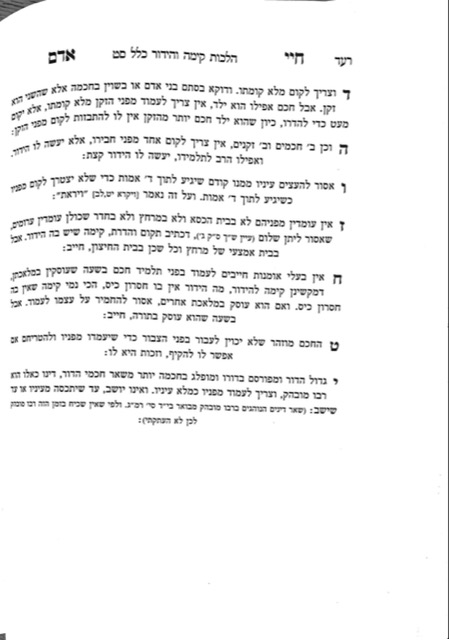We are discussing the halachos of kavod talmidei chachamim. In shiur 1491, we left off with the question of whether there can be a chiyuv hiddur even if there is no chiyuv kimah, or whether they are inexorably tied together.
The Sefer Chareidim writes that the chiyuv of hiddur is to speak to the talmid chacham in a way which is befitting. The Chofetz Chaim quotes the Sefer Chareidim in the introduction to his sefer, and writes that if one does not speak properly to a talmid chacham or about a tolmid chacham, they are transgressing the mitzvas asei of vehadarta pnei zakein. Such a person may also fall under the umbrella of bizayon of talmidei chachamim, which we will talk about later, be’ezras Hashem. Thus, we see that hiddur can be its own mitzvah, not limited to being tied to kimah.
Other examples include that the Gemara says that one should let a talmid chacham enter first, and the poskim have a machlokes about letting him leave first. When walking together, the talmid chacham should be in a position of respect, in a way that it is clear that the talmid chacham is the focus, and the other people are walking around him.
The Sefer ve’ahavta le’reiacha kamocha writes that once we understand that hiddur includes speaking to a talmid chacham in a befitting manner, anything which has become accepted as a vehicle for presenting kavod to someone would be a part of this chiyuv of hiddur. Every society has their own ways of showing people kavod; all of those would now become incumbent upon a person. For example, there is no chiyuv to speak to a rav or rebbe in third person, except towards a rebbe muvhak. However, if it has become standard to speak to all talmidei chachamim in third person, part of the mitzvah of hiddur will be to speak in such a manner.
Rashi, on the pasuk in chumash, writes that part of the chiyuv of hiddur is not to sit in the seat of a talmid chacham. The rebbe is able to give permission, because he is able to be mochel on his kavod. However, even if the rebbe has given permission, if people will think it is inappropriate, and there will be a concern of maris ayin, a person should avoid it.
Summary
The chiyuv of hiddur is not limited to situations of kimah, and includes speaking in a befitting manner to a talmid chacham, and any other vehicles for presenting kavod, as per accepted societal norms. Some examples include:
- Addressing a rebbe in third person;
- Not sitting in their seat;
- Letting a rebbe enter first;
- Ensuring the rebbe is placed in a position of prominence when walking together.



